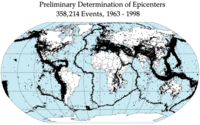
Photo from wikipedia
Abstract Probabilistic fracture mechanics (PFM) simulates the behavior of cracked structures and propagates uncertainties from input parameters to a failure probability or its uncertain estimate. In nuclear technology, this approach… Click to show full abstract
Abstract Probabilistic fracture mechanics (PFM) simulates the behavior of cracked structures and propagates uncertainties from input parameters to a failure probability or its uncertain estimate. In nuclear technology, this approach supports the assessment of the rupture probability of highly reliable pipes, which is an important parameter for the safety analysis of a nuclear power plant. For the appropriate probabilistic modelling of a structure with consideration of uncertainties, but also for the analysis of PFM application cases, the question arises, which input parameter of a probabilistic model has a higher impact on the estimate of computed failure probability, and which has a minor impact. This question is associated with the sensitivity measures or importance factors of the input parameters and their ranking concerning their influence. In this paper, six different approaches for the quantification of the sensitivity of parameters PFM evaluations are investigated: the amplification ratio, the direction cosine, the degree of separation, the analysis of the most probable failure point, the separation of uncertainty method, and the simple sample-based sensitivity study. Each method is described and visualization provided, applied to a common test case, and compared. The application case and the comparison are part of the Coordinated Research Project (CRP), “Methodology for Assessing Pipe Failure Rates in Advanced Water-Cooled Reactors (AWCRs)” by the International Atomic Energy Agency (IAEA), which is dedicated to the development of failure rates of piping in AWCRs. The participants used different PFM computer codes to analyze the test case and individual sensitivity methods to rank the input parameters, which motivated the comprehensive survey. The predicted parameter ranking of the approaches is consistent between the methods and between different PFM codes, but the approaches differ in the scope and the required effort. A conclusion and recommendation for the six different approaches are given.
Journal Title: International Journal of Pressure Vessels and Piping
Year Published: 2021
Link to full text (if available)
Share on Social Media: Sign Up to like & get
recommendations!